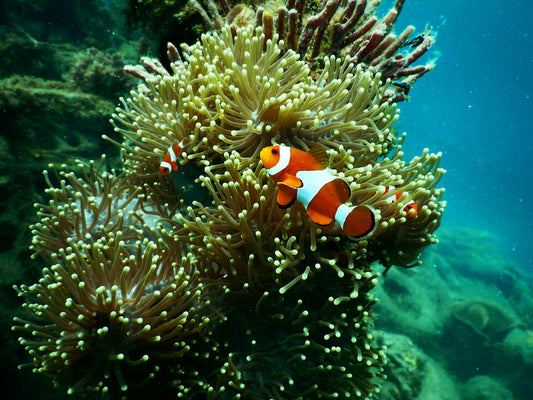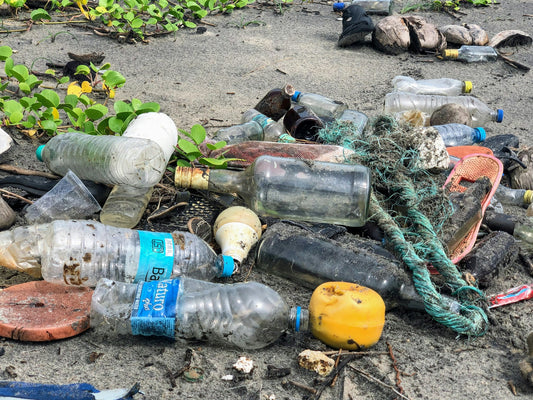Share
If you're a sceptic of plastic bans and you hate soggy paper straws, let me convince of the opposite.
In summary you'll learn:
- The past shows that listening to science actually works
- The plastic pollution crisis is at a tipping point
- We need unified action to solve this problem
- Plastic bans are just a piece of the puzzle
--------------------------
Doing online research, I stumbled across a recent article from CBC about the plastic lobby sueing the Canadian government for its single-use plastic ban.
Whenever I read online articles, I like checking out the comments, as they can be interesting, funny, and sometimes a little shocking.
While a majority of commenters were supportive of the ban and rooted in favor for the government, some comments were indeed more on the shocking side.
Some readers rooted for the plastic lobby for the simple reason of "Paper straws suck", while others went as far as deeming the ban a "...progressive virtue that won’t do much other than make life more expensive and difficult, a green left specialty. ..."
And these sceptics are not alone. While 75% globally want single use plastics banned, this means that 2 billion people worldwide still oppose the concept.
If you are one of these sceptics, I hope you give me a chance to convince you of the opposite. Let's look at...
...The Past, The Present, And The Future
The Past: Listening to Science Actually Works!

Did you ever wonder, why we do not get baked by the sun? Part of it is thanks to the ozone layer.
In 1985, the British Atlantic Survey rang an alarm. After monitoring the earth's stratosphere above antarctica for decades, the scientists were certain that humans had caused a big hole to form in the earth's protective ozone layer.
Why care? The ozone layer acts as a natural filter that shields the earth from harmful ultraviolet (UV) radiation in the sunlight and is closely connected to the earth's climate system.
A damaged ozone layer poses a significant threat to
- Health: overexposure to UV radiation is linked to skin cancer, a weakened immune system, and other severe health effects for humans and animals.
- Food security: plants like crops and fruits are damaged through UV light, which poses a risk for global food production.
- Global climate: the ozone layer regulates earth's temperature by absorbing and re-emitting heat from the into space. A damaged ozone layer causes global warming and more extreme weather conditions.
The scientists argued that the widespread use of chlorofluorocarbon (CFC) in beauty, health, home appliances, and other major industries were the main cause for the ozone hole.

They urged the United Nations (UN) to ban CFC and other ozone-depleting chemicals, as they cause reactions that damage ozone and harm the earths athmosphere at a significant rate
The world listened and under coordination of the UN, all 197 member states signed the Montreal Protocol to phase out CFCs. The protocol went down in history as one of the most successful examples for unified action against environmental challenges.
While it will take another 50 years for the ozone layer to fully recover, the Montreal Protocol was an essential step to prevent a potential ecosystem collapse and it limited the global temperature increase by at least 1 °C since then.
The Present: The Plastic Pollution Crisis Is At A Tipping Point

Today, we are facing another major envrironmental crisis: plasic pollution.
We produce approximately 400 million tons of plastic waste every year, a staggering 91% of which qualifies as single-use plastics. That means after using the items once, they end up in the trash or in nature.
In fact, every year 11 million tons of plastic enters the world's oceans every year, harming marine wildlife and ecosystems. If we keep up the pace of global plastic usage, this number is expected to rise to 29 million tons by 2040.
But plastic does not hurt wildlife alone, it also directly affects us humans. As plastic does not biodegrade, it breaks down into tiny microplastic particles over time.
These particles end up in the food chain and eventually are consumed by animals and ourselves.

It is estimated that humans consume a credit card worth of plastic every week and microplastic was already found in human blood, lungs, breast milk and even infants' bodies.
Scientists go as far as declaring microplastics the number one threat to human kind.
The UN as well declared plastic pollution one of the world's biggest environmental challenges of modern times and scientists warn we are nearing a dangerous tipping point of plastic induced ecosystem collapse.
If the past taught us something, it is that we should listen to scientists before their predictions come true.
The Future: We Need Unified Action To Solve The Plastic Problem
When it comes to finding solutions to the current plastic crisis, corporations and consumers like to play the blame game to evade the responsibility.
While consumers blame the lack of options and inflated prices for sustainable options, manufacturers go to great lengths to appear in a sustainable light (read about greenwashing tactics here) and shift the responsibility to the individual.
One of the most "successful" examples of blaming consumers is the incredible effort behind the big recycling lie.
Back in the 60s, when an environmental movement started to question plastic as a material, the industry invested millions over millions into campaigns to promote recycling and highlight the importance of sorting and recycling your trash as consumers.

As a result, you may still think today that, as long as you carefully sort your plastic items for the blue bin, they will be fully recycled.
Unfortunately, that is far from true. Globally, only 9% of plastic waste is recycled and the vast majority is burned or dumped in landfills, where the plastic takes hundreds of years to break down.
It is time to stop the blame game and adopt a holistic approach.
The global plastic problem is at a point where it needs to be addressed with a multi-faceted and coordinated approach that goes far beyond individual action and solves the problem at its source.
While individual consumers choices contribute to reduced plastic consumption, they are not sufficient to address the scale of the problem.
Organizations and regulators need to take decisive action to move the needle and use their leverage.
The success of the Montreal Protocol in addressing the CFC crisis demonstrates the power of unified action in tackling environmental challenges. We must learn from this example and apply the same level of commitment and cooperation to the plastic pollution crisis.
The success of restoring the ozone layer lies in the collateral action of banning CFC as a harmful chemical. Businesses, governments, and consumer groups worked together to develop comprehensive strategies to phase the chemical out of production and defined measures to support its restoration.
We must learn from this success story and apply the same level of commitment to tackle plastic pollution.
This is where plastic bans come in.
Several countries and cities have started to implement plastic bans that restrict specific single-use plastic items like straws and plastic bags, aiming to reduce waste and pollution.
And while plastic bans have gained popularity as a means to combat plastic pollution, there are critics who argue that these bans may not be as effective as intended or could even have unintended negative consequences.
Addressing The Main Arguments Against Plastic Bans

Some of the main arguments against plastic bans are
1. Impact on jobs and manufacturers:
Argument: Critics argue that plastic bans can negatively affect manufacturers by reducing demand for their products, leading to layoffs or even business closures.
Solution: However, some manufacturers have adapted by shifting their production to more sustainable alternatives, such as reusable bags or bioplastics, which saves jobs and helps businesses transition to more environmentally friendly practices.
2. Consumers may shift to worse alternatives:
Argument: Some argue that banning plastic bags may lead consumers to use other, potentially more harmful, alternatives.
For example, consumers may purchase thicker plastic bags to replace the secondary use of free single-use plastic bags as trashcan liners or to pick up pet waste.
Solution: To address this concern, it is essential to promote and provide access to sustainable alternatives, such as reusable bags made from eco-friendly materials.
3. Plastic bans may not address the root of the problem:
Argument: Critics argue that plastic bans may only address a small portion of the overall plastic pollution problem, as plastic bags are not the largest source of plastic pollution.
Solution: While this may be true, plastic bans can still contribute to raising awareness about plastic pollution and encouraging more sustainable practices.
Additionally, plastic bans can be part of a broader strategy to reduce plastic waste, including promoting recycling and reducing the production and consumption of single-use plastics
4. Some alternative solutions may have a bigger CO2 footprint:
Argument: One of the favorite arguments raised by the plastic lobby is the relatively low CO2 impact of plastic compared to other materials.
Studies show that for example a cotton shopping bag needs to be used several hundred or even thousand times to make up for the CO2 caused by its production compared to a plastic bag.
Solution: What this argument fails to acknowledge is that most damage induced by plastic is after it's use, and that there is a variety of sustainable alternatives that do not use virgin plastics and have a low CO2 footprint.
These alternatives need to be subsidized and promoted, and consumers need to be educated.
Plastic Bans Are Just A Piece Of The Puzzle
As you can see, the main arguments are justified. Just as the users above are right to dislike paper straws and argue that plastic bans only lead to rising consumer prices,
But most critics view plastic bans as a sole measure.
In order to be effective, regulators need to formulate and communicate plastic bans as one instrument that is part of holistic strategies against plastic pollution.
These strategies need to entail measures like subsidizing investments in material innovation and waste management, removing littered waste from the environment, and preventing greenwashing, alongside with transparent education and communication towards citizens.
If implemented on a global scale, gradually banning problematic plastic items as part of a holistic strategy can tackle the problem at it's source, by limiting the massive overproduction and overconsumption of plastic.
Just as the discussed plastic bans in the US and Canada need to be part of a broader strategy to eliminate single-use plastic.
Only if we limit the production of plastic, other measures can be fruitful and our planet can slowly recover from the tons of plastic that we dumped on it.

The next time you are annoyed by your soggy paper straw in a plastic lid on a plastic cup (however stupid this may seem), think about it as a stepping stone, rather than a meaningless drop in a bucket.
We hope you enjoyed this article. If you want to read more like this, make sure to check out our Blog and follow us on Instagram. If you are interested in truly sustainable products, check out our Shop.
If you want to engage in the discussion, feel free to leave a comment below.








